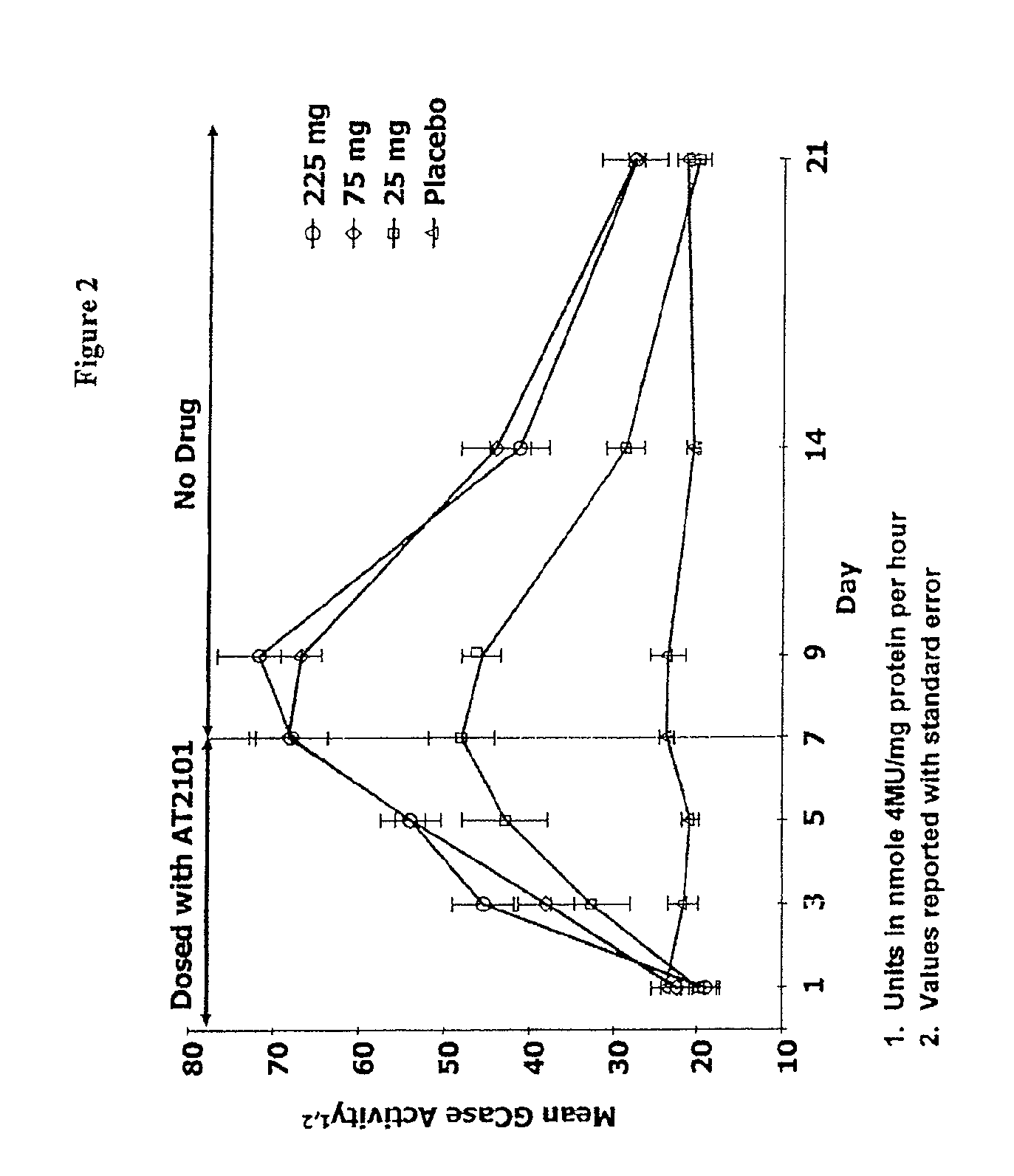Dosing regimens for the treatment of lysosomal storage diseases using pharmacological chaperones
a technology of lysosomal storage and dosing regimen, which is applied in the direction of metabolism disorder, extracellular fluid disorder, peptide/protein ingredient, etc., can solve the problems of protein stability reduction, protein level of biological activity reduction, and preventing protein folding properly
- Summary
- Abstract
- Description
- Claims
- Application Information
AI Technical Summary
Benefits of technology
Problems solved by technology
Method used
Image
Examples
example 1
Dosing Regimen for the Treatment of Gaucher Disease Using Isofagomine Tartrate
[0226]The primary objective of the study is to evaluate the safety, tolerability and pharmacodynamics of two dose regimens of orally administered IFG tartrate in patients with type 1 GD. As indicated above, the prevalent mutation in Type 1 GD is N370S.
[0227]This will be a Phase 2, randomized, two dose group, open-label study to assess the safety and tolerability of isofagomine tartrate. The study will be conducted in treatment-naïve patients with type 1 GD between the ages of 18 and 65 years. Approximately 16 subjects will be enrolled.
[0228]This study will consist of a 7-day screening period, followed by randomization for qualifying subjects, a 24-week treatment period, which will be followed by a 14-day follow-up period.
[0229]Visits are scheduled at Day −7 (±3 days), Day 1 (±3 days), Day 7 (±3 days), Day 14 (±3 days), Day 28 (±3 days), Day 56 (±3 days), Day 84 (±3 days), Day 112 (±3 days), Day 140 (±3 day...
example 2
Dosing Regimen for the Treatment of Gaucher Disease Using Isofagomine Tartrate
[0257]The primary objective of the study is to evaluate the safety, tolerability and pharmacodynamics of one dose regimen of orally administered IFG tartrate in patients with type 1 GD.
[0258]This will be a Phase 2, randomized, two dose group, open-label study to assess the safety and tolerability of isofagomine tartrate. The study will be conducted in patients with type 1 GD between the ages of 18 and 65 years. Approximately 16 subjects will be enrolled.
[0259]Visits are scheduled at Day −7 (±3 days), Day 1 (±3 days), Day 7 (±3 days), Day 14 (±3 days), Day 28 (±3 days), Day 56 (±3 days), Day 84 (±3 days), Day 112 (±3 days), Day 140 (±3 days), Day 168 (±3 days) and Day 182 (±3 days). If a subject is withdrawn from the study after Day 1 and prior to study completion, the subject will be encouraged to undergo all procedures scheduled at Day 168 (visit 10).
[0260]This study will consist of a 7-day screening peri...
example 3
Administration of Single Dose DGJ to Evaluate Safety, Tolerability and Pharmacokinetics, and Affect on α-Galatosidase a Enzymatic Activity
[0264]This example describes a randomized, double blind, placebo controlled Phase Ib study of twice daily oral doses of DGJ to evaluate the affects of DGJ on safety, tolerability, pharmacokinetics, and α-Galatosidase A (α-GAL) enzymantic activity in healthy volunteers.
[0265]Study Design and Duration.
[0266]This study was first-in-man, single-center, Phase Ib, randomized, double-blind, twice daily-dose, placebo controlled study to evaluate the safety, tolerability, pharmacokinetics, and α-GAL enzymantic activity affects of DGJ following oral administration. The study tested two groups of 8 subjects (6 active and 2 placebo) who received a twice daily-dose of 50 or 150 mg b.i.d. of DGJ or placebo administered orally for seven consecutive days, accompanied by a seven day follow up visit. Subjects were housed in the treatment facility from 14 hours prio...
PUM
| Property | Measurement | Unit |
|---|---|---|
| time | aaaaa | aaaaa |
| time | aaaaa | aaaaa |
| of time | aaaaa | aaaaa |
Abstract
Description
Claims
Application Information
 Login to View More
Login to View More - R&D
- Intellectual Property
- Life Sciences
- Materials
- Tech Scout
- Unparalleled Data Quality
- Higher Quality Content
- 60% Fewer Hallucinations
Browse by: Latest US Patents, China's latest patents, Technical Efficacy Thesaurus, Application Domain, Technology Topic, Popular Technical Reports.
© 2025 PatSnap. All rights reserved.Legal|Privacy policy|Modern Slavery Act Transparency Statement|Sitemap|About US| Contact US: help@patsnap.com



